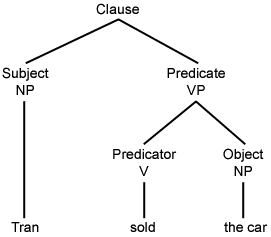Clauses
Clauses are made by combining phrases into an organised, grammatically complete structure. Each complete basic clause minimally contains a subject and a predicate. Clauses can be distinguished by their structure into a number of different types depending on their transitivity, form, and polarity.
ContentsRelated pages |
Subject and predicate
A key characteristic of basic clauses is that they are made up of one subject and one predicate. Consider the following examples:
SUBJECT |
PREDICATE |
|---|---|
Doug |
is happy. |
Debbie |
left the house early. |
Sandy |
is gorgeous. |
The cat |
is chasing a mouse. |
Your purple dress |
looks great with those shoes. |
The trees on this side |
are all very shady. |
This distinction between the subject and the predicate is based on the function of the parts of the clause. It is of long standing and works well for English. This distinction is also reflected in the structure of a basic clause. This is shown in the following diagram where the first branching in a structure tree shows the split between subject and predicate.

In English, the terms predicate and verb phrase are equivalent, but they reflect different perspectives on the clause. 'Predicate' describes a semantic function while 'verb phrase' refers to a unit of structure.
Semantics and subjects
People often have the intuition that the subject in English is the actor in the clause. This happens pretty frequently but it is not always true. The reason a definition like this does not work is because we define the subject according to grammatical rather than semantic criteria. (Relevant grammatical criteria include the presence of third person singular verb agreement, position in the clause, case marking on pronouns and so on. A full description of the subject is discussed in the page on transitivity.) Consider the following examples that contain subjects but not actors.
SUBJECT |
PREDICATE |
|---|---|
The rosy cheeked lady |
knows Chinese. |
My cat |
has had a stroke. |
Doug, Sandy and Jude |
were breathalysed on the way home. |
Categorising clauses
Clauses can be categorised according to their transitivity, their form, their polarity (negative or positive) and their status (independent or dependent).
Transitivity
Transitivity describes the verb or the clause in terms of the number of basic constituents (mostly noun phrases) that are required to make the clause grammatical. The verb determines the transitivity of the clause. There are five patterns of transitivity: intransitive (for example She is sleeping), complex intransitive (for example She seems nice), transitive (for example She ate an apple), complex transitive (for example She calls it her favourite fruit), and ditransitive (for example She gave me the apple).
Read more about transitivity...
Clause types
Three major clause types are: declarative (for example, Bridget will be home at five), interrogative (for example, Will Bridget be home at five?) and imperative (for example, Be home at five). Basic clauses are always declarative.
Read more about clause types...
Polarity
Negation can be added to a clause to change its polarity. For example I love eating oranges is a positive clause while I do not love eating oranges is a negative clause. Basic clauses always have positive polarity.
Status
Clauses can be independent, also called main clauses (for example, We decided to continue with the bike ride), or dependent, also called subordinate clauses (for example, although it was raining...).
